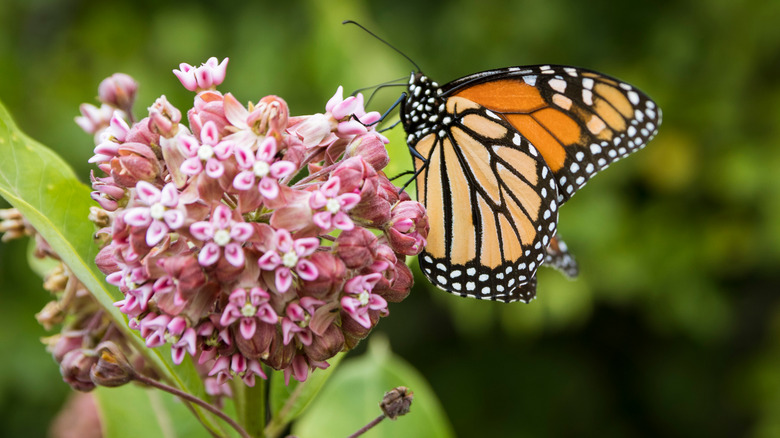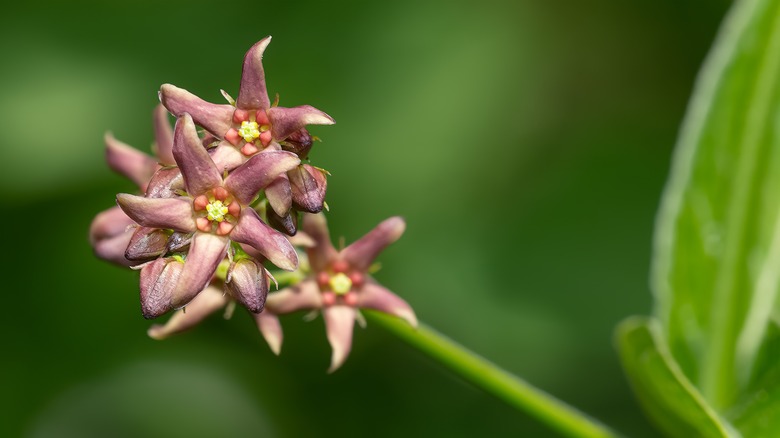The Invasive Milkweed Look-Alike You Don't Want Growing In Your Yard
Just because a plant is pretty doesn't mean it's good to have in your yard. Swallow-wort or dog-strangling vine (Cynanchum rossicum/Vincetoxicum rossicum) and black swallow-wort (Cynanchum louiseae) are good examples of this. These are invasive vines that are easily confused with common milkweed (Asclepias syriaca L.), a beneficial flowering plant found in yards and fields throughout the eastern United States. From their elongated, teardrop-shaped seed pods to their colorful, pointed-petal flowers, the plants do look alike. But being able to tell the difference between them is crucial, since swallow-wort should be eradicated from your garden. On the other hand, milkweed, which can pop up in sunny areas, can benefit pollinators while adding color to your space.
While it may be tempting to nurture any flowering vine that pops up in a landscape, the swallow-wort is a semi-aggressive variety that can quickly take over and outcompete native species. Another huge concern is that it confuses monarch butterflies that typically lay eggs on milkweed leaves, the singular source of food for monarch larvae. When eggs are laid on toxic swallow-wort instead, the larvae don't survive. Therefore, if you suspect that a plant in your yard may be swallow-wort instead of a variety of milkweed that butterflies love, it should be removed and prevented from growing back before it does damage to the monarch population and to your green space.
Identifying characteristics of milkweed and swallow-wort
June through July, in USDA hardiness zones 4 to 8, flowers appear on the invasive swallow-wort with five-pointed petals opening up in small clusters. The black variety produces dark purple blooms with visible, soft white hairs. Lighter pink, hairless flowers grow on the pale swallow-wort that are typically longer than those of the darker variation. These flowers don't grow in large, spherical clusters. On the other hand, common milkweed flowers, which grow in zones 3 through 9, are usually pink with five petals as well and grow in a large spherical shape with lots of bloom clusters. While swallow-wort's petals are more spread out, milkweed's often have a rounded shape and are closer together. Looking closely at the color and appearance of these flowers should help you differentiate between them.
Furthermore, swallow-wort's leaves are dark and shiny and 2 to 5 inches long with sharp tips. Milkweed's are large and thick with a deep midrib, the thick vein that runs along the center of the leaf, and the bottom of the leaves are a light green shade. Both plants also have very similar seed pods that split open in the fall and produce silky, fluffy fibers along with tiny seeds. However, to tell them apart, the invasive species' pods are slightly smaller, growing between 1 to 3 inches long, while milkweed's grow to be 4 inches long.
Removing swallow-wort from your yard
Once you've identified swallow-wort on your property, remove and destroy all seed pods, ideally before they open. Cut or break them off and throw them away. Then, use a spade or shovel to dig up the entire root system. Simply pulling out the parts of the plant above ground will prove ineffective, since the entire root crown must be dug up to prevent regrowth. Also, while mowing over the plants when the pods are still immature can reduce seed dispersal, unless the root crown is completely removed, the plant will actually grow back larger the next season.
Furthermore, you can also use herbicides once the plant begins to flower. Glyphosate sprays by Roundup or triclopyr ester by Garlon and Pathfinder have been shown to work well on swallow-wort. However, be aware that these chemicals can harm butterflies, so ensure you only spray the swallow-wort and not milkweed or other plants. Lastly, don't make the common weed disposal mistake that will have them growing back in no time, i.e. not getting rid of the plants properly. The parts that are cut back should be disposed of in a sealed bag or burned, because pods that aren't destroyed or removed from the area are likely to produce more plants.


